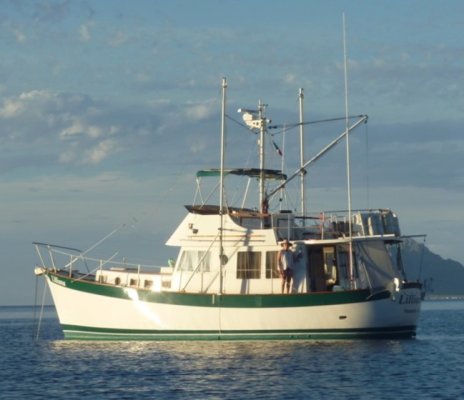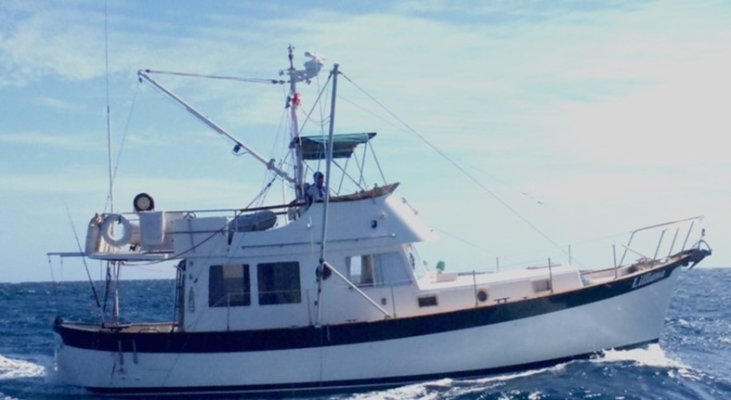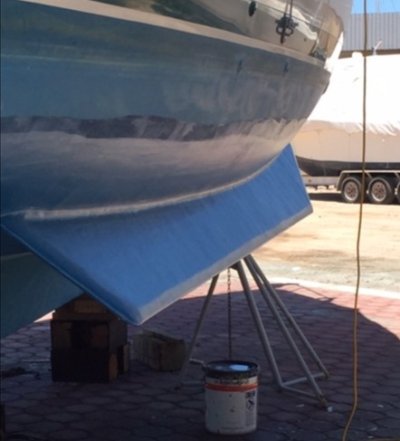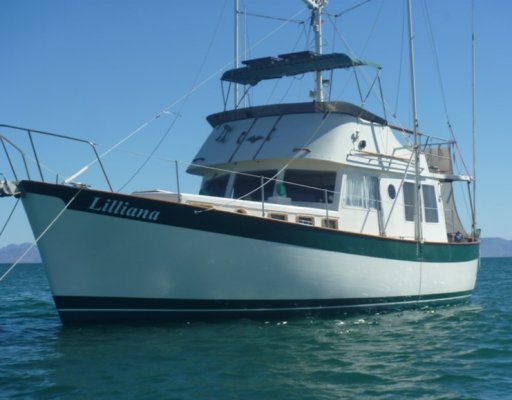mvweebles
Guru
- Joined
- Mar 21, 2019
- Messages
- 7,780
- Location
- United States
- Vessel Name
- Weebles
- Vessel Make
- 1970 Willard 36 Trawler
I am listing this at the request and on the behalf of the owner of Lilliana. She is a 1977 model W40 Sedan/Flybridge. Owner is asking $165k
Lilliana has been owned by a very knowledgeable sailor and active part-time cruiser since 2007 with many upgrades and is reportedly in ready-to-cruise condition with a 2500 nm range.
Construction of Hull #21 began at the Willard Marine facilities in Costa Mesa, CA in May 1977 and she was launched in January 1978. The flying bridge deck is 1" thick balsa core; and the fore-cabin roof is 1/2" to 1/4" balsa core. The cabin sides are 3/4" plywood core (glass-over). Willard still produces boats at the same California yard as Lilliana was launched, though they ceased recreational boat production in 2001.
I will try to get more interior pictures and more details. Owner is cruising in the Sea of Cortez as I write and not always easily available. He plans to list it with a broker in San Carlos MX (5-hr drive south of Arizona/Mexico border).
While I have not been aboard Lilliana, I have been aboard the owner's other boats: a Willard 30 he cruises in SE Alaska; and a 35-foot vintage sailboat he sails on SF Bay. Both were in immaculate condition. A W40 cruises at 7-1/4 kts and burns about 1.5 gph.
An interesting design feather of the W40's is the center/thwart fuel tank vs saddle tanks on either side of the engine. A center-tank orientation reduces effect on trim as the tank is drained (a big problem on some boats, especially the early N46s). And it makes for a cavernous engine room.
W40s do NOT have stand-up engine rooms which while nice, would greatly increase the height (and A/B ratio) of the boat. W40's are designed with 7000 lbs of concrete/steel-punching ballast against a 30,000 lb displacement (light load) for almost 25% ballast/displacement ratio - more than double Kadey Krogan or Nordhavn.
Willards appeal most to ex-sail cruiser converting to trawlers who value efficiency, simplicity, and ruggedness. The are a non-nonsense/no-frills trawler that will reliably get you where you want to go in comfort.
Finally, Willards have a devoted and passionate owners group with over 400 owners and followers. Perhaps the first owners' group ever, our extensive archives include mimeographed newsletters from the late 1960's when W36's roamed the Pacific, long before affordable electronics and radar. These are solid boats that travel well.
For more information, please contact the owner rpackard@berkeley.edu. If you have any trouble reaching him, feel free to ping me via PM. I have asked for additional interior pictures.
Peter




Lilliana has been owned by a very knowledgeable sailor and active part-time cruiser since 2007 with many upgrades and is reportedly in ready-to-cruise condition with a 2500 nm range.
- Paravane Stabilizers
- Flopper-stopper at-anchor stabilizers
- Get-Home electric motor belt-attached to shaft
- Pisces 27 generator
- 600 gallons diesel plus 55 gallon day tank
- Fuel polishing system
- Perkins 6.354 (135hp) new in 2000
- Roll-chock stabilizer fins
- SSB/Ham Radio plus Pactor/SailMail system
- Watermaker
- 250 gals water in Stainless Steel tank
Construction of Hull #21 began at the Willard Marine facilities in Costa Mesa, CA in May 1977 and she was launched in January 1978. The flying bridge deck is 1" thick balsa core; and the fore-cabin roof is 1/2" to 1/4" balsa core. The cabin sides are 3/4" plywood core (glass-over). Willard still produces boats at the same California yard as Lilliana was launched, though they ceased recreational boat production in 2001.
I will try to get more interior pictures and more details. Owner is cruising in the Sea of Cortez as I write and not always easily available. He plans to list it with a broker in San Carlos MX (5-hr drive south of Arizona/Mexico border).
While I have not been aboard Lilliana, I have been aboard the owner's other boats: a Willard 30 he cruises in SE Alaska; and a 35-foot vintage sailboat he sails on SF Bay. Both were in immaculate condition. A W40 cruises at 7-1/4 kts and burns about 1.5 gph.
An interesting design feather of the W40's is the center/thwart fuel tank vs saddle tanks on either side of the engine. A center-tank orientation reduces effect on trim as the tank is drained (a big problem on some boats, especially the early N46s). And it makes for a cavernous engine room.
W40s do NOT have stand-up engine rooms which while nice, would greatly increase the height (and A/B ratio) of the boat. W40's are designed with 7000 lbs of concrete/steel-punching ballast against a 30,000 lb displacement (light load) for almost 25% ballast/displacement ratio - more than double Kadey Krogan or Nordhavn.
Willards appeal most to ex-sail cruiser converting to trawlers who value efficiency, simplicity, and ruggedness. The are a non-nonsense/no-frills trawler that will reliably get you where you want to go in comfort.
Finally, Willards have a devoted and passionate owners group with over 400 owners and followers. Perhaps the first owners' group ever, our extensive archives include mimeographed newsletters from the late 1960's when W36's roamed the Pacific, long before affordable electronics and radar. These are solid boats that travel well.
For more information, please contact the owner rpackard@berkeley.edu. If you have any trouble reaching him, feel free to ping me via PM. I have asked for additional interior pictures.
Peter




Last edited:
